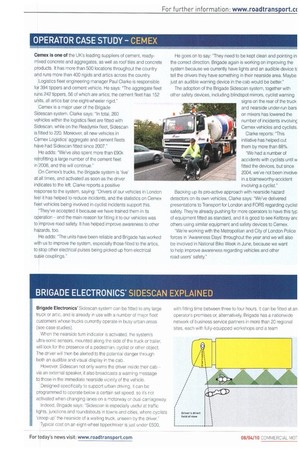OPERATOR CASE STUDY CEMEX
Page 45

If you've noticed an error in this article please click here to report it so we can fix it.
Cemex is one of the UK's leading suppliers of cement, readymixed concrete and aggregates, as well as roof tiles and concrete products. It has more than 500 locations throughout the country and runs more than 400 rig ids and artics across the country.
Logistics fleet engineering manager Paul Clarke is responsible for 394 tippers and cement vehicle. He says: The aggregate fleet runs 242 tippers, 56 of which are artics; the cement fleet has 152 units. all artics bar one eight-wheeler rigid."
Cemex is a major user of the Brigade Sidescan system. Clarke says: "In total, 260 vehicles within the logistics fleet are fitted with Sidescan, while on the Readymix fleet, Sidescan is fitted to 220. Moreover, all new vehicles in Cemex Logistics' aggregate and cement fleets have had Sidescan fitted since 2007."
He adds: "We've also spent more than £90k retrofitting a large number of the cement fleet in 2008, and this will continue."
On Cemex's trucks, the Brigade system is 'live. at all times, and activated as soon as the driver indicates to the left, Clarke reports a positive response to the system, saying: "Drivers of our vehicles in London feel it has helped to reduce incidents, and the statistics on Cemex fleet vehicles being involved in cyclist incidents support this.
!They've accepted it because we have trained them in its operation and the main reason for fitting it to our vehicles was to improve road safety. It has helped improve awareness to other hazards, too.
He adds: "The units have been reliable and Brigade has worked with us to improve the system, especially those fitted to the artics, to stop other electrical pulses being picked up from electrical susie couplings.' He goes on to say: "They need to be kept clean and pointing in the correct direction. Brigade again is working on improving the system because we currently have lights and an audible device tc tell the drivers they have something in their nearside area. Maybe just an audible warning device in the cab would be better."
The adoption of the Brigade Sidescan system, together with other safety devices, including blindspot mirrors, cyclist warning signs on the rear of the truck and nearside under-run bars on mixers has lowered the number of incidents involvinc Cemex vehicles and cyclists.
Clarke reports: "This initiative has helped cut them by more than 88%.
"We had a number of accidents with cyclists until w fitted the devices, but since 2004, we've not been involvei in a blameworthy-accident involving a cyclist."
Backing up its pro-active approach with nearside hazard detectors on its own vehicles, Clarke says: "We've delivered presentations to Transport for London and FORS regarding cyclist safety. They're already pushing for more operators to have this typ of equipment fitted as standard, and it is good to see Keltbray anc others using similar equipment and safety devices to Cemex.
"We're working with the Metropolitan and City of London Police forces in 'Awareness Days' throughout the year and we will also be involved in National Bike Week in June, because we want to help improve awareness regarding vehicles and other road users' safety."








































































































































